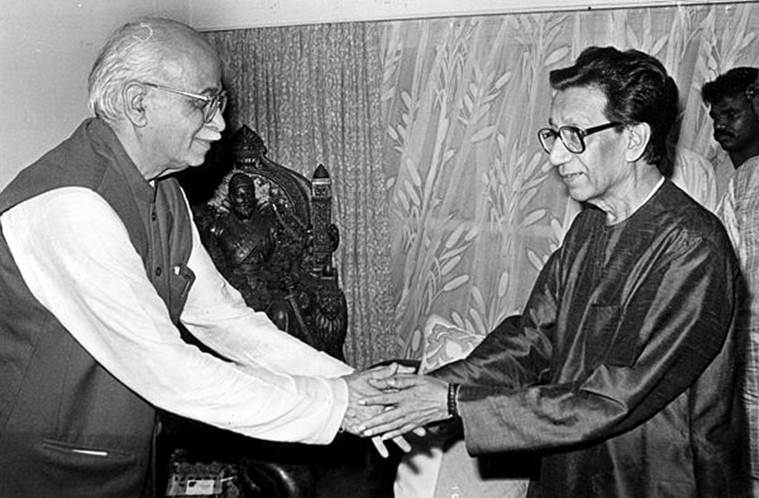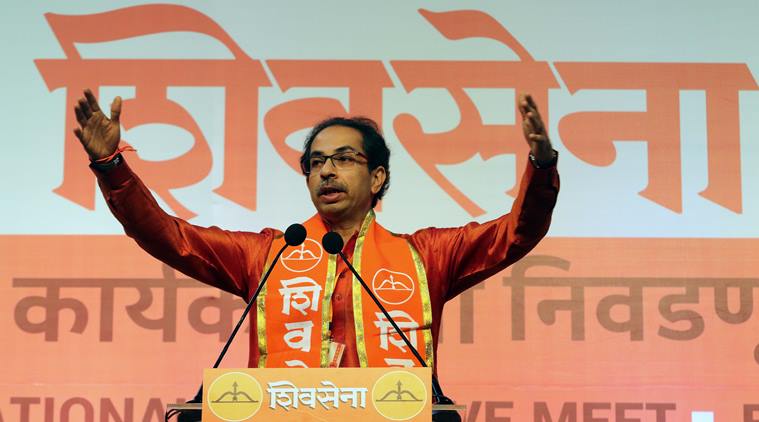The Bombay of the 1960s was part of a state that had just been born after a tedious linguistic rearrangement of borders. This newly restructured state, however, at this point in time was caught in a curious economic condition. While industrial growth and employment opportunities rose in the state in significant ways, there was a parallel increase in the number of job seekers. It was Bombay, particularly, that was caught in this battle, with the city witnessing a phenomenal increase in the number of University graduates, with not as many jobs for them to cash on. In these circumstances of duress on the part of the educated Maharashtrian youth, there arose a cartoon weekly, the Marmik or “straight from the heart”, that put across in the most pungent and cynical way, the woes of the “Marathi manoos”.
The founder of this weekly magazine was a 34-year-old cartoonist who had been working for an English newspaper. Bal Thackeray’s intent behind the conceptualisation of the Marmik was to offer a humorous, light-hearted take on everyday politics to the readers. But week after week, the magazine had a similar tone – that to showcase the plight of the ‘Marathi manoos’ in the hands of first the South Indians and Communists and then later the Muslims. By 1966, the magazine had reached a circulation of 40,000. Emboldened by the reception, Thackeray laid the foundation of a party that went by the name Shiv Sena. It is estimated that half a million people came together to listen to him at the party’s inaugural speech. Thackeray boldly announced that the Shiv Sena was not a party, but an army inspired by Shivaji, their goal being to advance the cause of the Marathi manoos.

 Bal Thackeray’s intent behind the conceptualisation of the Marmik was to offer a humorous, light-hearted take on everyday politics to the readers. (Express archive photo)
Bal Thackeray’s intent behind the conceptualisation of the Marmik was to offer a humorous, light-hearted take on everyday politics to the readers. (Express archive photo)
In the next few years and decades, Thackeray turned into a fierce political force within the fast industrialising landscape of Bombay. The Shiv Sena contested the municipal elections two years later and won one-third of the seats in the corporation. “From its beginning, the party made its imprint on local politics by championing the economic interests of Maharashtrians whose jobs, the party claimed, were being usurped by outsiders, particularly South Indians living in Bombay,” write political scientists Mary Fainsod Katzenstein, Uday Singh Mehta and Usha Thakkar in their article, ‘The rebirth of the Shiv Sena’. Further, right from its inception, the party was known for its violent and extreme methods of political action.
After its brief moment of fame in the 1960s, however, the Sena soon went into a period of lull, only to realise that the ‘sons of the soil’ strategy was no longer working and that they needed a new face to their political methods. This was when the party, in a severe change, of course, started placing more weight on the Hindutva ideology and in the ensuing decades turned into one of the oldest and strongest allies of the Bharatiya Janata Party (BJP). Together, with the BJP it roared across the length and breadth of Maharashtra and soon was able to make its presence felt outside the shores of the state. It is only recently, with the eruption of the Modi wave, that the Sena felt compelled to distance itself from the national party, hurling frequent criticisms on it. Earlier this year, it formally announced its decision to not support the BJP in the 2019 general elections.
The Sena with the BJP
From the 1990s on a new form of sloganeering emerged with the ranks of the Shiv Sena. “Garv se kaho hum Hindu hain, (say with pride, that we are Hindus),” was a rallying call that was a marked change from the ‘Marathi manoos’ catchphrase of the previous decades. This was accompanied by a severe form of criticism being hurled upon the Muslim community, portraying them as a burden for which the taxpayer had to bear the cost.
What explains this sudden shift in ideological and rhetorical stance on the part of the Sena? Though during its earliest days, the Shiv Sena had managed to become a formidable force, particularly in the Municipal Corporation, with its party members securing the Mayorship on four different occasions in the 1970s, its influence was largely limited to the city of Bombay and Thane. By the mid-1980s, the Sena realised the futility in carrying on with its emphasis on Marathi identity to earn political benefits and recognised the need to make a significant alteration to their ideological stance.
 Bal Thackeray with BJP leader L K Advani (Express archive photo)
Bal Thackeray with BJP leader L K Advani (Express archive photo)
From the mid-1980s, the party underwent an ideological makeover, emphasising themes of Hindu nationalism. “The Shiv Sena chief, Bal Thackeray, stepped up his anti-Muslim diatribe, urging his followers to take up a holy war or dharam yuddh,” write Katzenstein, Mehta, and Thakkar. The party spent handsomely on lavish celebrations of Hindu festivals and reached out to other Hindu parties to build alliances. The birth of the BJP during this period, with its official commitment to Hinduism, was of major consequence to the Sena.
Story continues below this ad
The eighties was the decade which saw the force of Hindutva raising its head prominently and spreading across North India. The Shah Bano case had become a political cause resulting in severe Hindu-Muslim animosities. Further, the Ram Janmabhoomi issue had led to widespread communal tensions across North India. Riding over this powerful wave of Hindutva was the BJP. The Sena, realising the moment to be most opportune formed an alliance with the BJP in 1989, while at the same time intensifying its rhetoric of anti-Muslim. The results were encouraging for both the parties. Maharashtra responded to this new discourse on Hindutva in the most welcoming way. Senior Sena leader Sudhir Joshi is known to have remarked, “We don’t know how it happened. But the Sena is getting a tremendous response from people of all walks of life. They seem to have caught on with our concept of Hindu rashtra.”
 Bal Thackeray with Atal Bihari Vajpayee (Express Archive photo)
Bal Thackeray with Atal Bihari Vajpayee (Express Archive photo)
It is noteworthy that in the 1990 Maharashtra Legislative Assembly elections, the BJP-Shiv Sena alliance won 94 seats in the Assembly – an increase of 16 seats on the part of the Sena. In the 1995 elections, the alliance secured 138 seats going on to form the government. In the 1996 parliamentary elections, the alliance won 15 seats. The alliance had succeeded in breaking into the Congress bastion. Despite the state having witnessed some of the strongest agitations, the Congress had reigned in the state up until 1996.
The Sena without the BJP
Saffron politics in India entered a whole new phase during the 2014 general elections, when the Narendra Modi wave swept across the country leading to a dramatic shift in power in favour of the BJP. After a sweeping victory in the parliamentary elections of 2014, an emboldened BJP demanded a higher seat-share in the state assembly. Sena founder Bal Thackeray had passed away just about two years back, and the BJP also appeared reluctant accepting the leadership of his son Uddhav Thackeray. Most importantly though, a BJP high on the achievements of the Modi wave was in no mood to play second fiddle to the Shiv Sena.
 Shiv Sena chief Uddhav Thackeray (Express File Photo)
Shiv Sena chief Uddhav Thackeray (Express File Photo)
The bickering that ensued led to the decimation of the 25-year-old alliance. However, after the BJP won the largest number of seats in the Assembly elections of 2014, the Sena decided to join the government following several rounds of negotiations. In the following four years though, strengthening of cracks within the party has been evident in the way the Sena kept criticising the ruling party at the center.
Story continues below this ad
In the recent past, as the Modi government completed four years in power. the Shiv Sena criticised it for failing to control fuel prices, its inability to end Pakistan-sponsored terrorism and also the increasing violence in Kashmir. The BJP was termed as ‘mad murderer’ that was out to get rid of anyone and everyone coming its way. Reportedly, in the recent past, the Sena also showered praise on Congress leader Rahul Gandhi, declaring him to be more dignified than Narendra Modi. In January 2018, the Sena announced its decision to snap ties with the BJP ahead of the 2019 general elections. As it completes 52 years on Tuesday, the party boldly announced that the “2014 political accident will not happen in 2019” and that the party will form a government in Maharashtra on its own.

 Shiv Sena founder Bal Thackeray with BJP leader Atal Bihari Vyajpayee (Express archive photo)
Shiv Sena founder Bal Thackeray with BJP leader Atal Bihari Vyajpayee (Express archive photo)
 Bal Thackeray’s intent behind the conceptualisation of the Marmik was to offer a humorous, light-hearted take on everyday politics to the readers. (Express archive photo)
Bal Thackeray’s intent behind the conceptualisation of the Marmik was to offer a humorous, light-hearted take on everyday politics to the readers. (Express archive photo) Bal Thackeray with BJP leader L K Advani (Express archive photo)
Bal Thackeray with BJP leader L K Advani (Express archive photo) Bal Thackeray with Atal Bihari Vajpayee (Express Archive photo)
Bal Thackeray with Atal Bihari Vajpayee (Express Archive photo) Shiv Sena chief Uddhav Thackeray (Express File Photo)
Shiv Sena chief Uddhav Thackeray (Express File Photo)





























